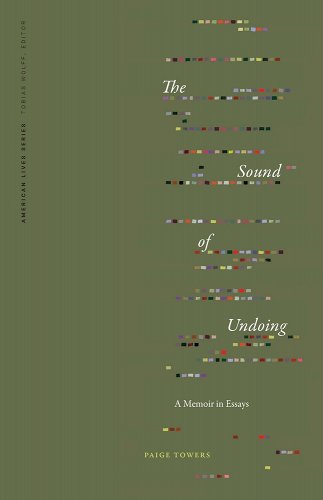Reviewed by Emily Webber
 The prologue of Paige Towers’ The Sound of Undoing: A Memoir in Essays (University of Nebraska Press 2023) contains a scene where the author recalls watching another child draw. This scene mainly focuses on the sounds produced and how these sounds call up memories of Towers’ sister.
The prologue of Paige Towers’ The Sound of Undoing: A Memoir in Essays (University of Nebraska Press 2023) contains a scene where the author recalls watching another child draw. This scene mainly focuses on the sounds produced and how these sounds call up memories of Towers’ sister.
As much as I concentrate on watching her draw, I listen even closer. Unlike the squeaky reet reet of a marker or the fuzzy iii-sss of a pencil, a crayon has a softer, rounder sound, shifting with how much pressure one applies to the tool: a light shading or delineating produces the scratchy short vowel a-aaa. The destruction of more wax amplifies the a-aaa and then adds a low eek eek as the crayon is no longer pressed onto wood pulp, but instead onto another slippery layer of wax.
With a hyper-focus on sound throughout the memoir, Towers uses sound to examine her past and present. Sounds bring her both pleasure and pain. She focuses on the duality of sound—how it can help and heal. Sound is how she hopes to understand how her sister became estranged from her and work through her inner struggles. She writes, “During the past few years, I’d noticed that sound seemed to be the connecting force between my past and present. Everyday noises snapped me back into moments from my childhood. I heard kids laughing and thought of my sister.”
Aside from being a captivating personal memoir, The Sound of Undoing is incredibly well researched. Towers skillfully weaves in researched information on sound. The result is a memoir you can’t turn away from while you also learn a lot about the science of sound. At the end of each essay, she uses supplemental information to describe how sound harms and heals, including an extensive bibliography at the end of the book. This mixture of content doesn’t impact the flow of the memoir at all.
Towers writes insightfully about how the intricate nature of people impacts our connections with them and with ourselves. In the opening essays, we learn that her father also is extremely sensitive to sound, and their life is ruled by it. She creates a complex, layered portrait of her father. He seems to be a hard man to live with, battling his issues, yet kind and loving. Towers’ relationship with him changes, yet they never abandon each other. We also learn that as a teenager her sister goes to a week-long evangelical religious camp at the invitation of a friend. Everyone thinks it will be harmless, but her sister returns completely changed and eventually becomes estranged from her family. Towers’ ability to distill a situation down to a few powerful sentences is evident in her writing about her family. She says of her father: “You can control a family because they love you. They need you. They adjust.” And of her sister: “I relied far too much on one person, one child, for my happiness and security. I see that now.”
While her sister is a shadow over everything in the memoir, Towers’ most raw and powerful writing is about her own struggles with mental health, about her father, and her marriage. These subjects must have taken an enormous amount of courage to write. While a primary focus, her sister is less alive on the page perhaps because it is harder to write about someone so drastically changed and who has essentially turned into a ghost. Yet readers can see what a loss of connection does to a family and the long-lasting harm of waiting and wondering about the lost relationship.
What I believe Towers conveys so well is the shifting nature of people and the impact of those changes on our relationships, whether due to changes from old age, children growing or shifting political and religious belief. Sometimes those relationships last despite the changes; other times, the people are lost to us. The book describes the sometimes agonizing, sometimes confusing, always painful process of losing someone and her writing about these changes will resonate with readers.
The book is part of the American Lives Series edited by Tobias Wolff. The books in the series always deliver a strong sense of place. In Towers case, she details life in the Midwest, New York City, and, finally, Milwaukee – always defined by sound.
On a clear sky morning on Memorial Day in 2018, I made a list of every sound I could hear from the back porch of our little house in the Riverwest neighborhood of Milwaukee. It included the following sounds: my neighbor’s brindle-coated pit bill snoring in the grass, the fading bass music of a car several blocks away, a motorcycle backfiring, the Our Lady of Divine Providence’s bells ringing out the hour. If I had listened in the early afternoon instead, I maybe would have written down “distant gunshot” right after “the whirr of a hummingbird’s wings.” This is because, that afternoon in a nearby park in Riverwest, a young poet was shot and killed just a dozen feet away from where children played.
In the title essay “The Sound of Undoing,” Towers describes how her father records things from the television on VHS tapes and how he plays, rewinds, stops, and starts so many times that the recordings eventually warp and change superimposing over themselves. This description seems to embody the core and structure of how this book unfolds, and how life flows—a mix of the past, present, and future, and how we process it all.
As The Sound of Undoing progresses, the essays focus more on Towers’ relationship with her husband, herself, and the places they live before returning to her family. Towers’ life is not without hardship; yet she maintains her relationships even when they are at their most challenging and works through her own issues. In the end, the absence of sound — that hope that you might one day hear from a loved one again but don’t — causes the most pain. It is easy to let the pain take over. Happiness and well-being are harder to achieve and maintain. Towers keeps fighting for the latter by trying to understand the pain of the past.
 Emily Webber’s writing has appeared in The Writer magazine, the Ploughshares Blog, Five Points, Maudlin House, Brevity, and Slip Lip Magazine. She’s the author of a chapbook of flash fiction, Macerated, from Paper Nautilus Press. Find more at emilyannwebber.com and on Twitter: @emilyannwebber.
Emily Webber’s writing has appeared in The Writer magazine, the Ploughshares Blog, Five Points, Maudlin House, Brevity, and Slip Lip Magazine. She’s the author of a chapbook of flash fiction, Macerated, from Paper Nautilus Press. Find more at emilyannwebber.com and on Twitter: @emilyannwebber.


